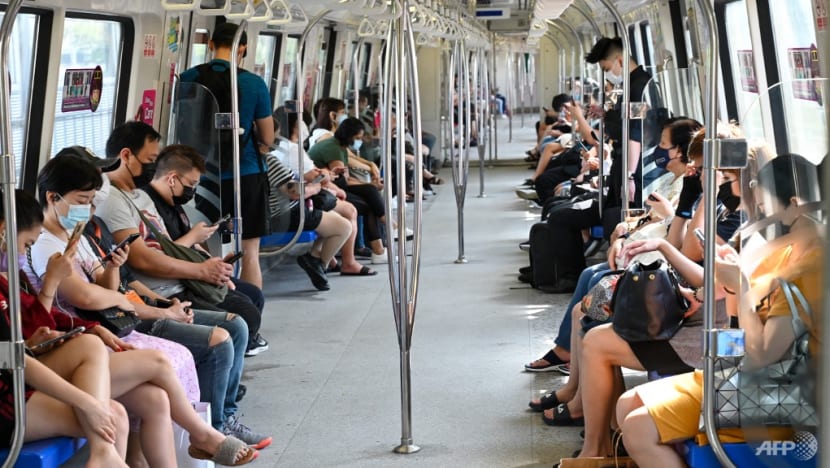Public Transport Council starts review of the way bus, train fare adjustments are calculated

Commuters on board an MRT train in Singapore on Nov 5, 2021. (File photo: AFP/Roslan Rahman)
SINGAPORE: A review of the formula and mechanism for adjusting public transport fares is under way, with the process likely to be completed by the first half of next year.
“The Public Transport Council (PTC) has commenced the review of the public transport fare adjustment formula and mechanism. Such reviews are typically done once every five years,” the council said in a news release on Monday (Aug 15).
“It targets to complete the review by the first half of 2023 and apply the outcome of the review from the 2023 fare review exercise.”
During the review, PTC will examine the effectiveness of the current fare adjustment formula and mechanism, taking into account changes in the public transport industry and commuting patterns.
The council will also propose means to “better maintain the balance to keep public transport fares affordable while ensuring the financial sustainability of the public transport system”, it said.
The council said that it will consult and engage key stakeholders, including commuters, public transport operators, the labour movement and transport experts, in the course of the review.
The current fare adjustment formula and mechanism will apply to the 2022 fare review exercise, PTC added.
CURRENT FORMULA
Set four years ago, the current formula for calculating the maximum fare adjustment takes into account the following factors:
- The year-on-year change in the core consumer price index (core CPI)
- The year-on-year change in the wage index (WI), measured by the average monthly earnings (national average), adjusted for any change in the employer’s Central Provident Fund (CPF) contribution rate
- The year-on-year change in the energy index (EI), a composite index derived from diesel prices and electricity tariffs
- The year-on-year change in the network capacity factor (NCF), which measures capacity provision relative to passenger demand for the entire public transport system
- The productivity extraction factor (0.1 per cent in the 2018 formula), which is based on half of the productivity gain achieved by public transport operators
For 2018 to 2022, the maximum fare adjustment is: 0.5 core CPI + 0.4 WI + 0.1 EI - 0.1 per cent + NCF
The previous revision to the formula saw an increase in the weightage of core CPI from 0.4 to 0.5 alongside a decrease in the weightage of EI from 0.2 to 0.1.
There was no change to the WI, and the productivity extraction factor remained at half of the operators’ productivity gains.
The NCF was introduced in 2018 “to better reflect the cost movements due to changes in public transport network capacity and commuter usage”, PTC said at the time.
















